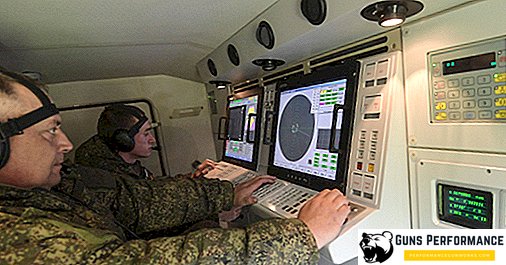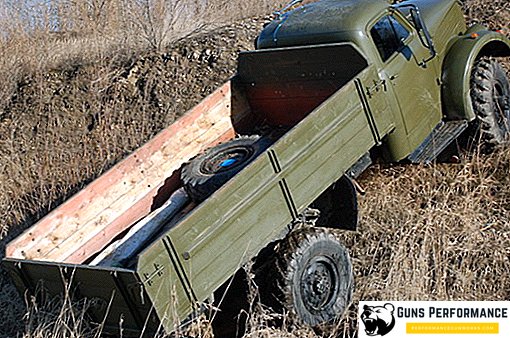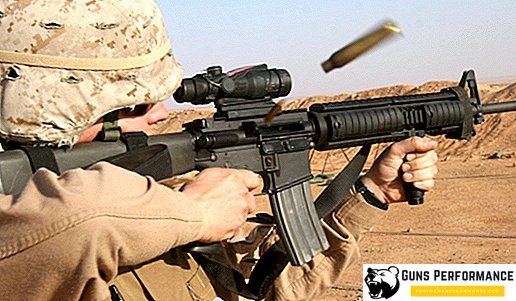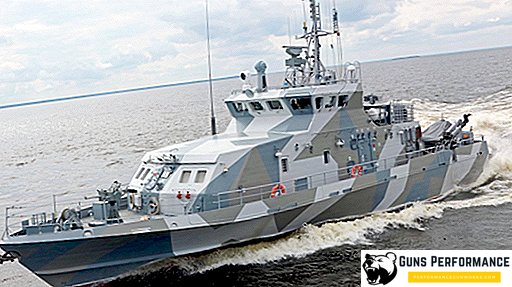The idea to have armed vessels on large rivers and inland vast areas is not new to the Russian fleet. Beginning with the first days of the establishment of Soviet power, river flotillas began to form on all major rivers and lakes — connections of ships and watercrafts performing military functions. Initially, for this purpose, ordinary river steamers and boats armed with small arms and artillery were used. Later, special vessels began to arrive at the equipment of river and sea flotilla - monitors and armored boats, representing a separate class of military vessels. Combat use proved in practice the high efficiency of the courts of this class, to the share of which many glorious and tragic moments fell during the Civil War of 1918-1920. and during the Second World War.

Today, the glorious battle traditions of the Soviet river armored boats and monitors are continued by small artillery ships. These are universal and unique military vessels capable of solving a huge range of operational and tactical tasks. A striking example of the successful implementation of the idea of a powerful and modern ship designed for service in the internal waters is the ships of project 21630.
The history of the birth of the project of small artillery ships
On the territory of such a vast state as the Russian Federation is, there are a large number of large rivers and lakes, other large areas. As it turned out, a reliable military presence is of paramount importance for ensuring the normal functioning of inland waterways, tactically and strategically. Earlier, river gunboats, monitors and armored boats coped with this task. Today the ships of these classes have become history. They were replaced by new, more advanced warships of the "river-sea" class.
Do not forget that Russia has an extensive maritime boundary in the Caspian Sea, the largest closed reservoir of the planet. This maritime theater needs full-fledged naval-type warships capable of simultaneously walking on the sea, using shallow river routes and a system of river channels.
The main task facing the river military courts at present is in the following aspects:
- the mastery of the waters of rivers throughout its length, control over the water space on large lakes and the adjacent marine area;
- patrolling of specified areas;
- support for ground action on the flanks during hostilities;
- conducting amphibious and military transport events.
Today, such tasks are successfully solved by artillery ships of the "Buyan" type, which are part of the Caspian military flotilla.
The decision to create universal combat vessels capable of operating on river highways and in the near-sea zone was made in the mid-90s. This was facilitated by the appearance in the Caspian Sea of military ships belonging to foreign fleets. With the collapse of the Soviet Union, the Caspian ceased to be an internal Soviet body of water. Now, in this maritime theater, in addition to the naval grouping of the Iranian Republic, naval units of Turkmenistan and Azerbaijan have been added. Accordingly, it was required to significantly strengthen the Caspian military flotilla.

For this purpose, it was planned to create, in a short time, full-fledged combat ships, with a displacement of up to 500 tons, which in their firing characteristics would be superior to any enemy in the Caspian Sea.
Zelenodolsk design bureau engaged in designing ships of this class. The project was based on climatic and hydrological features of the Caspian Sea and the Volga River in its lower course. The main requirements that were imposed on the designers were:
- high seaworthiness of vessels;
- the small draft allowing to move freely on shoal;
- long cruising range;
- the presence of powerful weapons.
The finished technical solution was the project 21630, which provided for the construction of a small artillery ship of the "Buyan" type. The new vessel, by its tactical and technical characteristics, size and displacement, was the most suitable for the class of corvettes. Accordingly, in the classification of military ships of NATO, the ship received the code Buyan class corvette.
The vessels of this class were designed for combat service in the waters of the near-sea zone, on rivers and lakes throughout the territory of the Russian Federation.
Practical implementation of the project 21630 "Buyan"
The first vessel was laid down in the winter of 2004 at the shipyards of the Almaz shipbuilding enterprise in St. Petersburg. The firstborn was called "Astrakhan", as it was initially oriented to equip the Caspian military flotilla. Construction of the first vessel lasted for 1.5 years, and was completed in October 2005. In the summer of 2006, the IAC "Astrakhan" was successfully transferred along the river line to the Caspian Sea and in September of the same year was incorporated into the Caspian military flotilla.

Serial construction was carried out at the production facilities of the shipyard “Almaz” and suggested a phased laying of ships of this type. Up to 2018, it was planned to launch 10 ships of the "Buyan" type, of which 5 ships are intended to equip the Caspian flotilla.
Based on the current situation during the construction, the original plans had to be abandoned. It was decided to limit the series to 7 sessions of this class. During 2006, various types of weapons were actively tested on the lead ships. The main emphasis was placed on practicing the combat use of the new “Gibka” air defense missile system, armed with projectiles for Igla MANPADS.
Following the Astrakhan in the summer of February 2005, the first serial ship, called the Kaspiysk, was laid down, but the launch of the ship was delayed for five years. The reason for the construction of the first production ship was the lack of clarity with the selection of weapons for new ships. The presence of only an artillery installation as the main fire weapon did not provide the solution of new operational-tactical tasks arising in the Caspian naval theater. In 2006, the third ship in the series was laid at the St. Petersburg shipyards.

Only in 2011, the first serial ship was launched and commissioned. With the new name, already "Volgodonsk", the ship in 2012 raised a naval flag. Following the IAC "Volgodonsk" the second serial ship Makhachkala came to the Caspian Sea. Both serial ships, together with the lead ship of the Astrakhan International Aviation Complex project, made up the strike connection of Russian ships in the Caspian Sea. The main combat mission of artillery ships was to ensure safe navigation in the near-sea zone, in the Volga river delta and protect Russia's interests in the 200-mile economic zone of the Caspian Sea.
Design features of small artillery ships project 21630 "Buyan"
All three combat ships built at domestic shipyards have Russian-made equipment, components and assemblies. When creating the project, it was decided to unify many design parameters, thus ensuring the possibility of preventive maintenance of ships by the ship repair companies in Astrakhan and Makhachkala. In parallel with the development of the draft ships for the needs of the domestic fleet, a draft ship was created, designed to fulfill export contracts. The export version of small artillery ships of the type "Buyan" of project 21632 was called the "Tornado". The export version differed from the base model by the possibility of installing other types of weapons.

Project 21630 became the base platform for the subsequent construction of the most successful modifications - small missile ships of the project 21631 of the "Buyan-M" type. Unlike the ships built according to the original design, rocket ships had a twice as much displacement (949 tons compared to 500 tons). The main armament of the ships of the new project was to be cruise missiles "Caliber", launched from vertical launchers of mine type.
Each such ship was supposed to carry up to 8 cruise missiles. The appearance of such a vessel in the water area of the Caspian Sea provided full control not only over the entire vast expanse of water, but also over the adjacent territories of neighboring countries.
Small artillery ships built for the Caspian military flotilla carried the most advanced technologies in their designs. So hull parts and superstructures of ships had a certain inclination and contours, reducing the radar visibility of ships for enemy radar. The main part of the navigation and radio equipment is hidden in the superstructure and deck planes. The materials used to create the design of ships, selected in accordance with the technology of "Stealth". The power plant of the ships is represented by a two-shaft diesel unit, which drives the jet propulsion unit. The ship could reach a maximum speed of 28 knots and withstand up to 7 points.

The main combat load was borne by an automatic artillery installation "A-190-01" with a caliber of 100 mm. In addition to the main caliber, 30-mm Ak-630 assault rifles and a Grad-M retractable installation of the 122-mm caliber system were installed on ships.
The air defense of the vessel was provided by the ZRK 3M-47 “Bending” installed in the aft part. Melee weapons were two machine gun turret 14.5 mm caliber. To counter the submarines on the ships were two grenade launchers.
Modern realities of the ships of the project 21630
At the present stage, the construction of small artillery ships for the needs of the domestic fleet has been suspended. The practical use of the ships of the project 21630 showed the urgent need to strengthen weapons. The development of the project was the laying of a new ship at Zelenodolsk Shipyard under the improved project 21631. The new ship "Grad Sviyazhsk" was already a completely different concept of a combat ship. The emphasis was on equipping the ship with missile strike weapons.

In 2014, the first ship of the improved project was put into operation. The Caspian military flotilla was replenished with a strike ship capable of striking not only in the Caspian Sea, but also at a considerable distance. The flight range of the Caliber cruise missile was 1,500 km.
In 2014, two more ships of project 21631 were commissioned and deployed to the Caspian military flotilla behind the lead ship. In 2018, new ships entered, armed with cruise missiles entered the Black Sea Fleet.
Success in the construction of ships of this class showed the correctness of the theory of equipping the existing fleet with small warships. At a certain stage, it is precisely such ships that are capable of effectively solving assigned tasks not only at the operational-tactical level, but also for strategic purposes. An example of the high combat qualities of the new ships, created on the basis of the ships of project 21631, were combat launches of cruise missiles of caliber from the waters of the Caspian Sea according to targets in Syria. The Caliber missiles launched from the Veliky Ustyug and Uglich small rocket ships, flying almost 2.5 thousand km, hit the designated targets of the Islamists on the territory of the Syrian Republic.
The further fate of the IAC project 21630 is today regarded as the realization of the export option. The construction of purely artillery ships for the needs of the domestic fleet was recognized as inexpedient.












